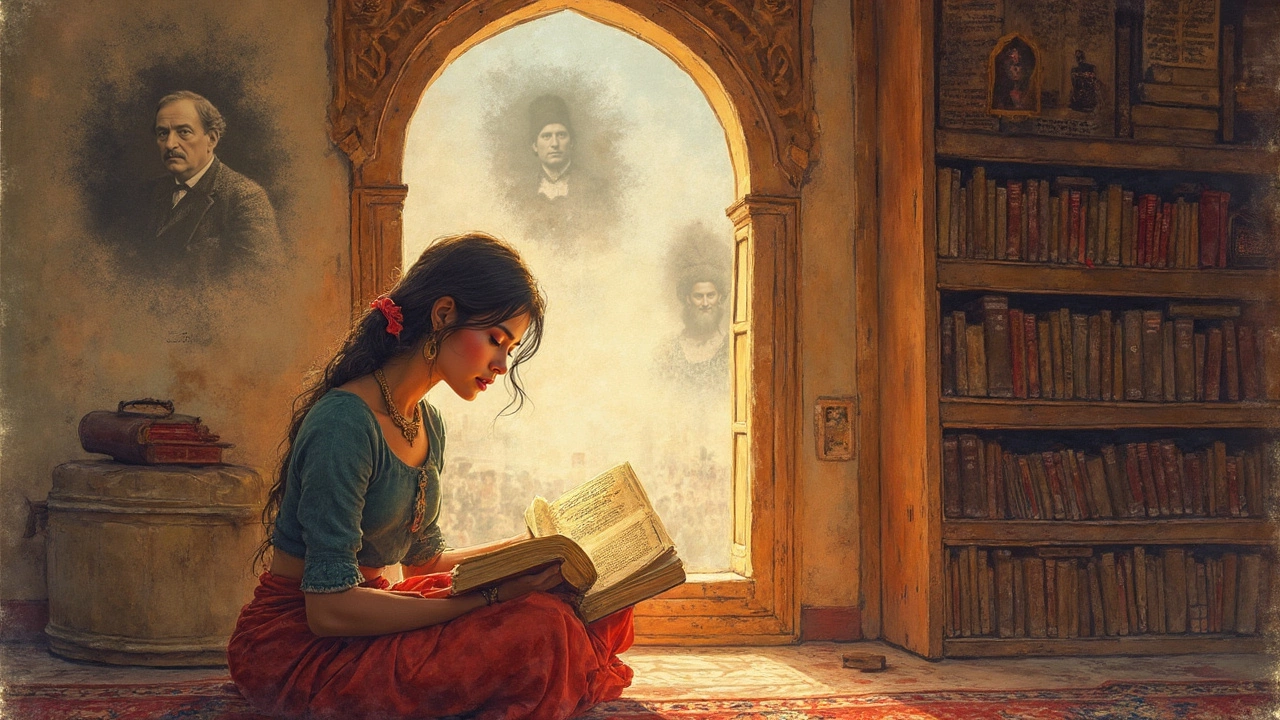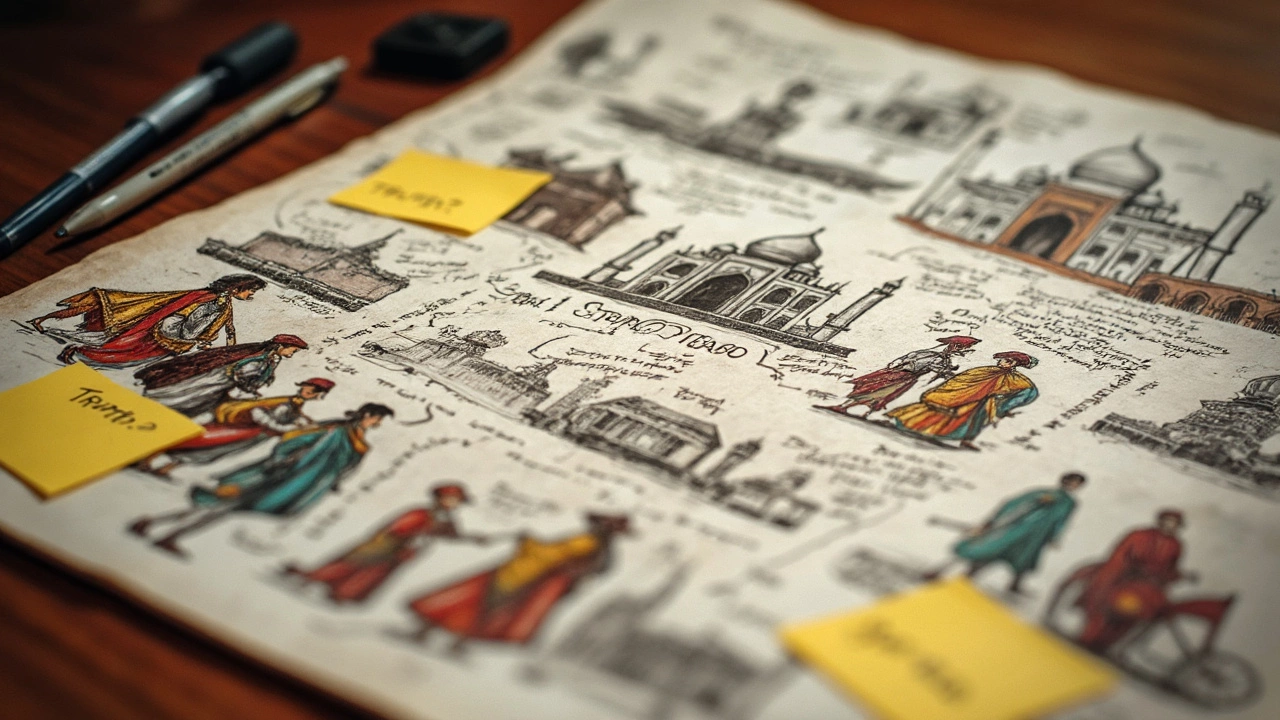What Qualifies as Historical Fiction? Your Guide to Spotting the Real Thing
 Apr, 19 2025
Apr, 19 2025
If you think slapping a dusty old date or a famous king’s name on a story makes it historical fiction, guess what? It’s not always that simple. Writers and readers argue all the time about what really counts. Is a novel set in 1990 historical yet? What about stories with made-up characters but real events?
Here’s a trick that experts use: the best historical fiction has two things—a real setting from the past and a vibe that actually fits the era. The story has to happen outside the writer’s own lifetime, usually by at least a generation, so they can’t just rely on memory. Authentic details matter too. You want to feel you’re walking those old streets or smelling gunpowder at a real battle, not wading through someone’s cheesy version of the Middle Ages.
But here’s the thing—writers get to invent characters, dialog, sometimes even plots. What pulls the story into historical fiction is the solid backdrop: real events, real politics, maybe even a few cameos by famous figures. If the main action could swap time periods and work just as well, it’s probably not true historical fiction.
- Defining Historical Fiction (Seriously, What Counts?)
- The Timeline: How Far Back Is "Historical"?
- Fact vs. Fiction: Balancing Truth with Story
- Research: What Makes Stories Feel Authentic
- Common Mistakes—and Easy Red Flags
Defining Historical Fiction (Seriously, What Counts?)
So, what really qualifies as historical fiction? It’s a hot debate, but most experts agree on a few basic rules. The story needs to be set in a specific and real time period that’s outside the writer’s own lived experience—usually at least 20-30 years back. For example, a novel written in 2025 and set in 2010 probably isn’t historical fiction yet, but one set during World War II definitely is.
Another big thing: the story has to deal with real-world settings, events, or social realities that come from history. You can have characters and plot lines that are made up, but the backdrop needs to stay loyal to the era. Think of Hilary Mantel’s "Wolf Hall"—she invents conversations and thoughts for Thomas Cromwell, but the Tudor politics and major events all follow the facts we know.
Check out these benchmarks most novels have to hit to count as part of the historical fiction genre:
- Actual Historical Setting: The time and place should anchor the story in a real era—like Victorian London, Ancient Rome, or Harlem in the Jazz Age.
- Era-Specific Details: Everything from clothing to technology and social rules should fit the time period.
- Real Historical Events or Figures: The story interacts with true events or real people, even if the main character is fictional.
- Clear Distance from Present Day: The author can’t use their own memories—the story must show a world that feels distinctly past.
There are some gray areas. For instance, alternate history (think Philip K. Dick’s "The Man in the High Castle") blurs the line by reimagining outcomes, but most critics still lump it under historical fiction if it sticks to era-accurate details except for the big "what if."
Fun fact: In 2023, the Historical Novel Society found that 80% of the best-selling historical novels took place more than 60 years ago. It looks like both writers and readers trust distance—more time means more room for fiction, but also more research to keep things real.
The Timeline: How Far Back Is "Historical"?
This question comes up all the time: How old does a setting need to be before a book officially counts as historical fiction? It’s not just nitpicking—there’s an actual rule used by most publishers and big book awards.
The basic guideline? The event or era should be at least 50 years before the author is writing. That means if you’re reading something published in 2025, the story should take place no later than 1975 to be legit historical fiction. The idea is, the author shouldn’t have been an adult living in that time—they should have to research, not just dig through their own memories.
Here’s a quick comparison:
| Book Setting Year | Published Year | Historical Fiction? |
|---|---|---|
| 1942 (WWII) | 2022 | Yes |
| 1990 | 2024 | No |
| 1865 (Civil War) | 2018 | Yes |
| 2001 | 2025 | No |
But some folks like to push the boundaries a bit. For example, stories about the 1980s written today are often called “retro” or “recent historical,” but not everyone buys into that label. Big award committees like the Walter Scott Prize stick to the 60-year rule: a story must be more than 60 years in the past from publication year.
So, next time you grab a "historical fiction" set in the 2000s, check the date—it’s probably just contemporary fiction in costume. Real historical fiction focuses on times you didn’t directly live through, and that’s what makes it different from just “old-school” drama.

Fact vs. Fiction: Balancing Truth with Story
This is where things can get messy in historical fiction. How much of the book should be pure fact? What's okay to make up? Readers want a story that feels real, but nobody expects every conversation or character to be pulled from the history books. The trick is blending just enough truth into the fiction that you believe what’s happening, while still enjoying a good tale.
Here’s how this usually shakes out:
- Big events and settings should be spot-on. If an author says the story takes place during the Chicago Fire of 1871, they can’t say it rained all week. That’s just not true. Same goes for who won a certain battle or when a specific law went into effect. These details are checked by plenty of sharp-eyed history fans.
- Fictional characters are the norm. Don’t expect to get inside Abraham Lincoln’s real head—authors don’t have time machines. A historical novel might feature a made-up soldier or shopkeeper hanging around real events. As long as the backdrop is correct, readers are usually cool with it.
- Dialogue is always imagined. Nobody knows exactly what people said in 1620, not even historians. Writers have to guess, but they need to avoid modern slang and keep it believable for the era.
You might be surprised to learn that some of the most popular historical fiction books take real mysteries and fill in the blanks with story. Agatha Christie’s “Death Comes as the End” is set in ancient Egypt—with real settings, but made-up drama.
If a story changes a huge fact, good authors explain themselves. You’ll often see a note at the end (called an Author’s Note) spelling out what’s real and what’s invented. If you finish a book and spot wild inaccuracies, check for that note—sometimes writers bend facts on purpose for a juicy story, but hiding it isn’t cool.
Writers walk a line. Go too heavy with the facts, and the book feels like a lecture. Add too much fiction, and it turns into pure fantasy. The books that really stand out balance research with imagination—and never mess up the important stuff.
Research: What Makes Stories Feel Authentic
Ever notice when a historical fiction book just feels legit, like you’re actually there? That’s no accident. Good authors put in serious homework before they write. They dig into old newspapers, diaries, letters, and even court records. They check out what people ate, what slang they used, what clothes they wore—sometimes even what their shoes smelled like by the end of the day.
If you’re reading about the American Civil War and the book talks about soldiers using smokeless gunpowder, get suspicious—smokeless powder wasn’t around until about 1884. Details like this can make or break the feeling of the book. Hilary Mantel, who wrote "Wolf Hall" about Thomas Cromwell (Henry VIII’s fixer), once said she fact-checked what vegetables were available in England in the 1520s so she didn’t put tomatoes in the stew by mistake. That’s commitment.
Here’s what authors usually double-check to keep things real:
- Timeline of events: Making sure fiction fits real-world history—no skipping big wars or moving famous speeches to the wrong year.
- Setting and background: Getting the buildings, countryside, and even the smells of a city right for that time period.
- Language and dialogue: Swearing, jokes, and daily talk have to sound right—nobody said “cool” in the 1700s.
- Clothing and objects: No zippers in medieval Europe, no smartphones in 1950s New York.
There’s real effort here. A 2022 survey of historical novelists found that most spend at least half their prep time researching before even starting Chapter One (and 15% spend over a year on research).
| Research Task | Typical Hours Spent |
|---|---|
| Reading historical sources | 100+ |
| Visiting locations | 10-40 |
| Fact-checking details | 80+ |
The payoff? Readers can spot fakes. When the background checks out, you lose yourself in the story. If the details are sloppy, it breaks the spell—and suddenly you’re just reading fiction with costumes. For both writers and readers, good research is what raises historical fiction above just another made-up story.

Common Mistakes—and Easy Red Flags
Let’s be honest—a lot of so-called historical fiction misses the mark. What trips up many writers and makes readers roll their eyes? Sometimes, it’s small mistakes. Other times, it’s just lazy research.
Watch out for these classic blunders:
- Using modern slang: Nothing snaps you out of a Victorian drama faster than a character saying “cool” or “whatever.” Did you know the word “teenager” didn’t catch on until the 1940s?
- Mixing up timelines: If a book set in the 1500s has tea-drinking English peasants, that’s a problem—tea didn’t show up in England until decades later. Or a character using a zipper in 1800? Impossible—they weren’t around until the 1890s.
- Ignoring real events: Sometimes stories claim to be about the Civil War but make no mention of major battles or historical figures. If the main plot could happen at any time, it’s not really grounded in historical fiction.
- Too-perfect characters: Modern attitudes or unlikely talents can stick out. For example, a woman running a bank in medieval Europe isn’t impossible but definitely rare. It needs solid context, not just wishful thinking.
- Geographic mistakes: Getting locations mixed up or bringing buildings into the story that didn’t exist yet is a dead giveaway. Like a character visiting the Eiffel Tower before it was built in 1889.
You can dodge these traps by double-checking those easy-to-miss facts. If you want to geek out on details, here’s how different types of mistakes show up:
| Mistake Type | Examples | Year(s) Involved |
|---|---|---|
| Language | Using "okay" in Tudor England | "Okay" = 1840s onward |
| Inventions | Gas lamps in ancient Rome | Gas lighting = 1790s+ |
| Food/drink | Potatoes in medieval France | Potatoes = after 16th century |
A golden tip: don’t just trust the story. When in doubt, Google when and where certain things actually showed up. Authentic historical fiction sweats the small stuff—and your reading experience is way better when it does.